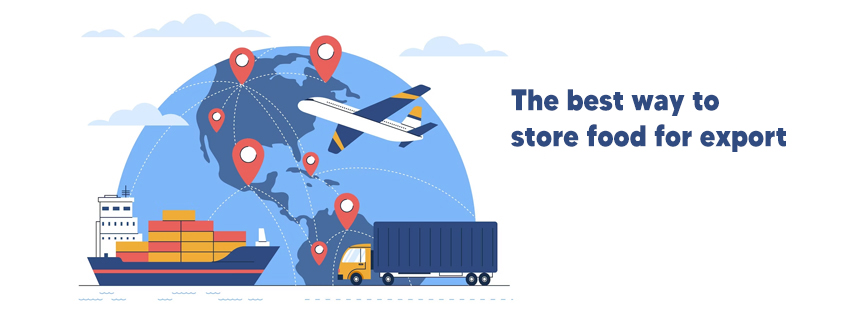What is The best way to store food for export? People around the world enjoy food from other countries. Yes! This is one of the most important reasons that we should be aware of the storage conditions of exported food products. Knowing the storage conditions of exported food products will help you, so that you can use the capabilities of food freezing well. All food and agricultural products that are transported for the purpose of export must be kept cold. Therefore, in this article, Karya Polymer talks to you about the challenges of exporting agricultural and food products. It also describes the best methods of preserving food for export. So stay with us until the end of this article.
How can the share of the agricultural products export be increased?
Food safety is always an important issue. The preservation and export of agricultural products and food has been the concern of humans and governments for a long time. Export of agricultural products and food is one of the important pillars of economic dynamism. Considering that agricultural and horticultural products are produced on a large scale, there should be a plan for their export. The following things help to increase the share of agricultural products exports:
- One of the things that increases the share of agricultural exports is the liberalization of trade in the agricultural sector. This will increase imports and exports.
- Reducing customs tariffs for the export and import of agricultural and food products
- Using suitable packaging for export and modern technologies
- Appropriate solutions for the correct transportation of agricultural products and food
Challenges of exporting agricultural products
As you know, different countries have their own rules and standards for importing and exporting food and agricultural products. Many countries in the world use rigid frameworks for the import of agricultural products. This disproportion and different import and export laws in different countries have limited the possibility of exporting agricultural products to other countries. Also, some countries prevent the entry of many food and agricultural products from other countries.
Failure to comply with global standards for the export of agricultural products is one of the most important reasons for the failure of the export of this food category. The absence of the following facilities causes losses and food spoilage and reduces their exports:
- Refrigerated containers
- Cargo planes
- Currency transfer problems
- Not using proper packaging
- Lack of infrastructure in factories to store and transport food and agricultural products
Iran’s challenges in exporting agricultural products
In the previous section, we mentioned the challenges of exporting agricultural products. It should be noted that in addition to the above-mentioned cases, we are facing many problems for exporting agricultural products in Iran due to the non-compliance of many international standards at different stages of production.
Indiscriminate use of chemical fertilizers during the cultivation of crops, use of some pesticides that are prohibited at the global level, and other such things cause a decrease in the quality of agricultural products during production. But the story does not end here.
Limitations imposed on Iran have limited a significant proportion of exports to neighboring countries. Of course, the problems of currency transfer and the lack of equipment such as suitable industrial refrigerators and special food cargo planes should not be ignored.
Considering Iran’s potential for producing many food and agricultural products, the lack of suitable refrigerators for storing and transporting food causes them to be damaged and wasted.
Probably, when you buy oranges in the summer season, you notice the frozen taste and its unnatural taste. Yes! The existence of equipment for storing agricultural products in the correct way is important for domestic and foreign consumers.
Another problem we are facing in Iran is lack of knowledge about suitable packaging equipment. Of course, in recent years, many companies have been producing suitable packaging equipment using up-to-date machines. But the number of these companies is very limited and the demand for this type of packaging is also less due to its higher price compared to previous methods.
New methods for packaging and storing food products
Different materials can be used for food packaging, such as plastic, glass, metal, paper and cardboard packaging. The design and performance of food packaging typically changes over time to meet consumer needs.
Below are some new packaging methods:
- Edible packaging
Following industry advances aimed at reducing waste and waste, researchers have designed a type of packaging called Wikicells. This packaging is actually part of the food and can be eaten.
Micro packages
This type of packaging is much thinner than human hair. The ingredients of micro-packaging include water, a soluble polymer and 70% clay. This micro-packaging can be placed in the category of environmentally friendly materials. Micro packaging has not yet been widely marketed.
- Smart packaging
A team of researchers from the University of Connecticut, Rutgers University, and Kraft Foods are investigating something called “electronic language.” An innovative technology that can effectively “taste” food through sensors embedded in packaging. If the food is contaminated or spoiled, the packaging changes color and warns the consumer. Dutch scientists are also developing a smart package with a built-in “release-on-order” preservative that saves food just before it spoils. Even the US military is looking into smart food packaging.
- Antimicrobial packaging
Antimicrobial packaging not only protects food from bacteria, but actively works against it. An Israeli student named Ronen Gottesman has developed “killer paper,” an antibacterial paper coated with silver nanoparticles that can fight to prevent germs from entering food.
- Water soluble packaging
A US company that makes water-soluble products has created the Vivos oral delivery systems, which are basically food pouches that dissolve in water. Plastic film packaging dissolves faster under hot water and does not taste when consumed.
- Self-cooling, self-heating packaging
While consumers and industry executives have long fantasized about self-cooling and self-heating food and beverage packaging, the reality is that there is no record of commercial success for this type of packaging.
The role of fresh-keeping bags in the export of agricultural products
The fresh bag is one of the new products for food packaging. Fresh keeping bags are very useful for exporting agricultural products. These bags increase the shelf life of fruits and vegetables up to 5 times its normal time. It is necessary to know that they design and produce fresh keeping bags according to the type of product. These bags control the atmosphere and the balance between existing gases and humidity. They also increase durability. This makes the use of these bags a suitable choice for exporting agricultural products.
Fresh-keeping bags are also produced in home types, called fresh-keeping bags, which, in addition to helping the family’s health, help the family’s economy by making fresh products available and reducing waste. Karya Polymer company produces fresh-keeping food bags using the latest technology and provides them according to the customer’s needs. If you intend to buy this product from Karya Polymer, contact our colleagues.
A US company that makes water-soluble products has created the Vivos oral delivery systems, which are essentially food pouches that dissolve in water. Plastic film packaging dissolves faster under hot water and does not taste when consumed.
- Self-cooling, self-heating packaging
While consumers and industry executives have long fantasized about self-cooling and self-heating food and beverage packaging, the reality is that there is no record of commercial success for this type of packaging.



